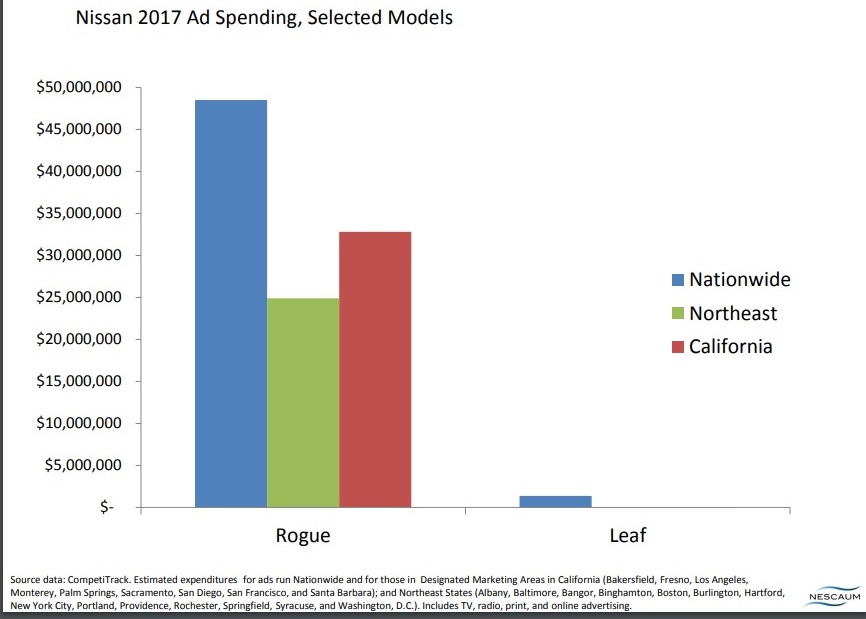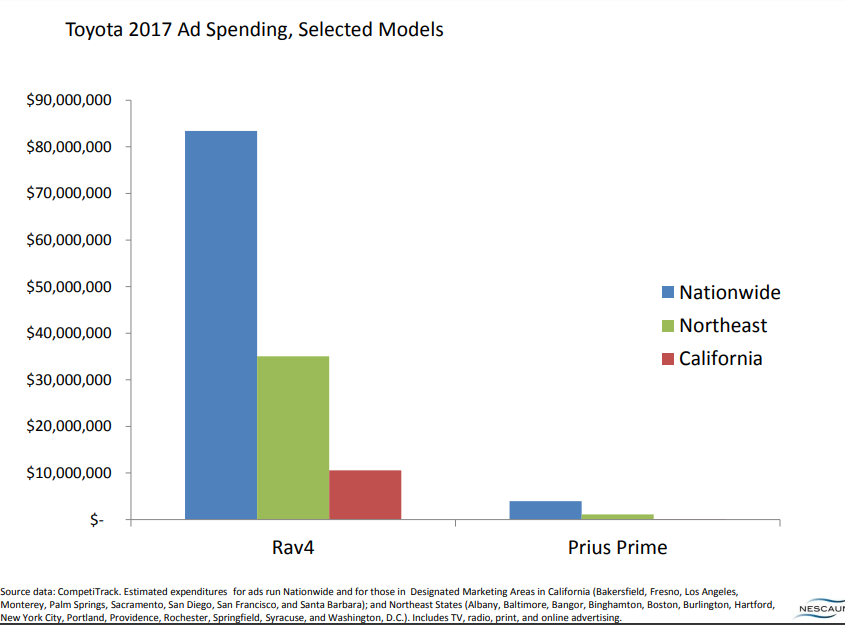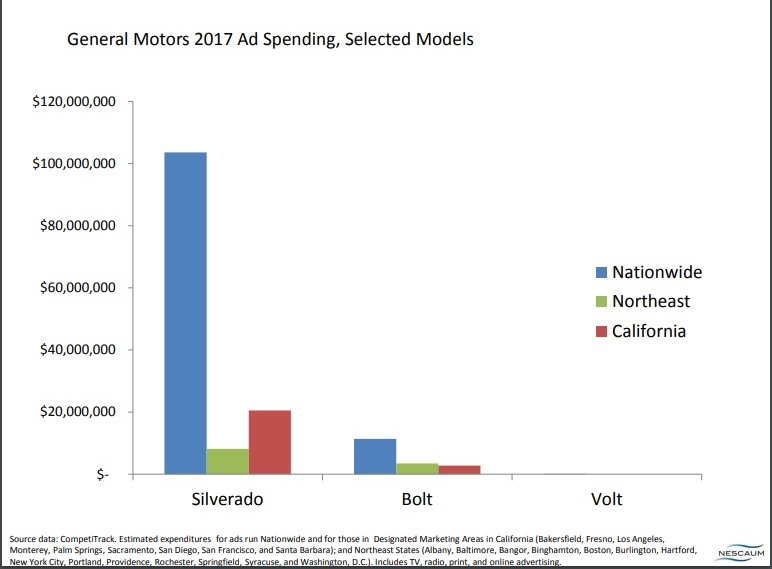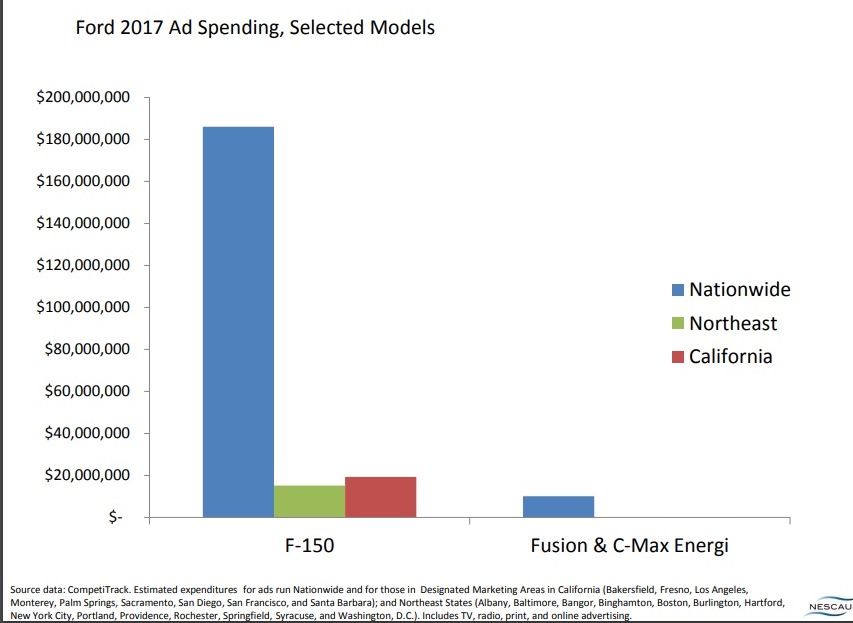In some parts of the country, you are more likely than ever to see your friend or neighbor driving an electric vehicle (EV). In the United States, electric vehicle sales rose 90 percent comparing July 2017 to July 2018, and we’re on track to hit 1 million EVs on the road in the U.S. by the end of this year.
Automakers are coming out with new models each year. Yet despite this momentum, automakers are doing the bare minimum to advertise and sell electric vehicles -- often, even less than the minimum.
A recent study commissioned by the Northeast States for Coordinated Air Use Management (NESCAUM) shows that six major automakers in the U.S. (General Motors, Ford, Toyota, Nissan, Volkswagen, and FiatChrysler) are spending almost nothing to advertise their electric vehicles. While consumers are loving these cars and state governments, utilities, and private investors across the country are spending millions of dollars to install EV charging stations, automakers are actually trying to slow the movement toward electric vehicles.
The data, shared recently with the Sierra Club and others by NESCAUM, is from CompetiTrack, a respected company that tracks auto industry advertising activity.
The report, which looks at 2017 automotive ad spending, shows that in California and Northeast markets as well as in nationwide ads, FiatChrysler didn’t advertise the electric Fiat 500e at all, and Volkswagen didn’t advertise the eGolf at all either. When examining data from California and the Northeast, Nissan, Toyota, and Ford also spent NOTHING on ads for the plug-in Leaf, Prius Prime, Fusion, and C-Max Energi, respectively.


Transportation accounts for more carbon emissions than any other sector in the United States. Electric vehicles are significantly lower in greenhouse gas emissions than conventional vehicles, even factoring in emissions from the electricity used to charge them. As we shift to more renewable sources of power, EVs become even cleaner over time. EVs are also much safer for air quality, with little to no tailpipe emissions that threaten public health. Federal fuel economy standards and state zero-emission vehicle mandates in the West and Northeast -- coupled with consumer demand and automaker innovation -- will result in an exciting shift to cleaner vehicles. But we need the automakers to lift a finger to reach more consumers.

Chevy, which appears to have spent more than any other company on EV advertising, spent roughly $16 million in total advertising for the Bolt, looking nationwide and specifically in California and the Northeast -- the markets where the “zero-emission vehicle mandate” is in place that requires automakers to sell increasing numbers of EVs. It would appear its modest investment paid off -- the Bolt was the nation’s second best-selling EV in 2017, coming in just behind the Tesla Model S. Oddly, the company spent nearly NOTHING in nationwide, California, or Northeast ads for to advertise the Chevy Volt plug-in hybrid.
Let’s look at Ford. In an April 2018 op-ed, Ford’s executive chairman, Bill Ford, and president/CEO, Jim Hackett, said “Looking forward, we know we will need... new technologies to measure environmental progress in an increasingly electric and connected world. We are building a future of smart vehicles in a smart world.” That sounds nice. But in reality, Ford is not putting its money where its mouth is -- the company spent almost nothing to advertise its plug-in models in 2017.
Ford also recently announced its plans to stop manufacturing and selling most of its sedan models in the U.S., including most of its plug-in models. We’ve seen the company has never been too serious about selling its plug-in models in any sort of mass volume (Ford’s plug-in models have never been among the top-selling EVs). And worst of all, Ford has been lobbying behind the scenes for the Trump administration to roll back the federal fuel-economy and GHG standards that were one of our greatest policies in place to cut climate change and dangerous air pollution -- not to mention policies that would mean less money needed by consumers to fuel their vehicles.

The EV advertising report was a follow up from one that NESCAUM commissioned a couple of years ago, which we also blogged about, that cited how little automakers mentioned EVs in their ads. In 2015, automakers advertised traditional models anywhere from 2 to 24 times more than their hybrids and electric vehicle models. Unsurprisingly, the newer data is largely the same. Despite an increase in the interest for EVs, automakers are still doing less than the bare minimum to get them on the road.
Automakers like to claim that “consumers just don’t want EVs.” The reality is that people love their EVs once they are exposed to them (I’m one of those people). In fact, at the upcoming National Drive Electric Week events (you can register here!), there will be upwards of 300 events nationwide where people can check out and often test drive these vehicles for themselves.
Cleaner vehicles are a bit more expensive for automakers to manufacture, but that will change as they shift to higher volumes and as battery prices continue to drop. The volume issue will be solved only by automaker effort to reach consumers: through advertising, increased inventory, and partnerships with dealerships on discounts and training.
In 2016, the Sierra Club recruited 174 volunteers to call or visit 308 car dealerships or stores in the 10 ZEV states to let us know about their EV shopping experience. According to the volunteers, most dealers -- in concert with automaker policy -- did everything they could to steer buyers away from electric vehicles: many dealerships did not have electric vehicles in stock, hid the electric vehicles at the back of the lot, and didn’t have trained salespeople ready to tout the many benefits of electric vehicles, including thousands of dollars in consumer state and federal tax credits and rebates. Several dealerships couldn’t even provide test drives because they had neglected to charge the cars. The majority of volunteer EV shoppers who visited Ford dealerships, for example, had a mediocre or negative shopping experience.
There were some dealers that our survey found were excelling at selling EVs, showing that with some effort, it is possible.
No one is saying that the auto industry needs to spend the same amount advertising electric vehicles as they do on their conventional models -- yet. But as our nation -- and the world -- continues to move toward electrifying and cleaning up the transportation sector, the auto industry should be touting to consumers all the great options. Even though General Motors still spent upwards of eight times more advertising the Silverado than the Bolt last year, the money spent on the Bolt clearly had a significant impact. Whether they like it or not, the market is moving toward EVs -- automakers can either take the time to invest in promoting them now, or we can all reap the climate, air quality, and consumer choice consequences later.